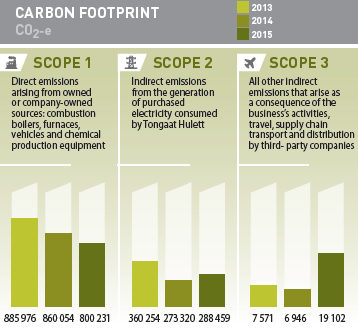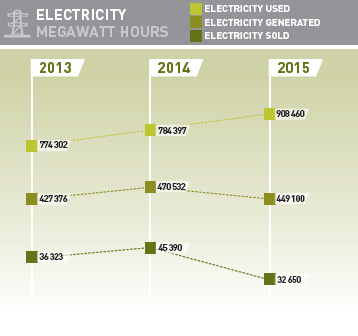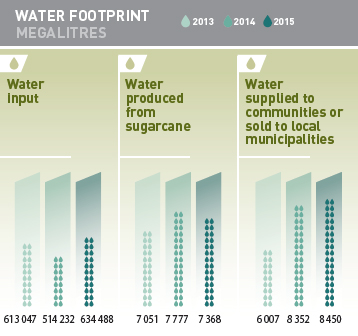Environment
| Natural capital | ||
| KEY ELEMENTS |
6 | CONSECUTIVE YEARS OF PARTICIPATION IN THE CDP PROJECT | |||
| 7% | REDUCTION IN SCOPE 1 GHG EMISSIONS ACHIEVED | ||||
| INCREASE IN RECYCLED MATERIAL VOLUMES AS A RESULT OF NEW PRACTICES | |||||
| KEY PRIORITIES GOING FORWARD |
PROMOTION AND IMPLEMENTATION OF SUSTAINABLE AGRICULTURAL PRACTICES | ||||
| CONVERSION OF AGRICULTURAL LAND TO DEVELOPMENT IN AN ENVIRONMENTALLY-SENSITIVE MANNER | |||||
ENVIRONMENTAL STEWARDSHIP
Globally, natural resources are under stress and ecosystem degradation is a material issue to all businesses, given the significance of sustainable natural capital to global socio-economic prosperity. As a major user of land, biodiversity and water, Tongaat Hulett’s agri-processing and land development operations, impact on the environment and local communities. As a responsible corporate citizen, Tongaat Hulett continues to demonstrate its commitment to sound environmental stewardship and considers legal compliance to be the minimum requirement from which to strive further and establish best practice methods in a sustainable and ethical manner.
In line with this approach, the company aims to retain and/or secure ISO 14001 certification at all its operations, thereby reflecting global industry standards that minimise environmental impacts.
CLIMATE CHANGE
Agriculture is vulnerable to changes in climate and weather patterns. Tongaat Hulett recognises the need to adapt to the physical impacts of climate change, which will affect operations, particularly through the availability of water and the occurrence of extreme weather events.
The company is making its operations more energy-efficient, and encouraging suppliers throughout its entire value chain to do the same. The company participates in public environment forums such as COP 21 (United Nations Climate Change Conference) and the Davis Tax Committee to contribute to discussions on this important topic.
CARBON MANAGEMENT
As part of its broader commitment to responding to climate change, Tongaat Hulett participated in the Carbon Disclosure Project (CDP) for the sixth year in a row. The CDP is an independent initiative encouraging transparency on all climate change-related issues and providing details of emissions performance. The company’s carbon footprint analysis was conducted according to the Greenhouse Gas (GHG) Protocol, a widely used international accounting tool. Details of the company’s actions underway are provided in the public response to the CDP (www.cdproject.net). Tongaat Hulett tracks and monitors its GHG emissions and will continue to improve the accuracy and reporting of its carbon footprint.
 During the year, business operations emitted 800 231 metric
tons CO2 equivalent (CO2-e) Scope 1 emissions. The company
purchased electricity that emitted 288 459 metric tons of
CO2-e. The total Scope 3 emissions were 19 102 metric tons
CO2-e covering business travel, comprehensive supply chain
transport and distribution by third-party companies. In the
2014/15 reporting period, employees booked nearly 4 000
business trips, flying more than 5,8 million kilometers, resulting
in 1 231 metric tons CO2-e being emitted from business travel.
The total Scope 1, Scope 2 and Scope 3 carbon emissions for the
period under review was 1 107 792 metric tons CO2-e and the
turnover was R16,155 billion, which equates to 69 grams of CO2
emitted per Rand generated. The GHG emissions have been
verified by a third-party service provider.
During the year, business operations emitted 800 231 metric
tons CO2 equivalent (CO2-e) Scope 1 emissions. The company
purchased electricity that emitted 288 459 metric tons of
CO2-e. The total Scope 3 emissions were 19 102 metric tons
CO2-e covering business travel, comprehensive supply chain
transport and distribution by third-party companies. In the
2014/15 reporting period, employees booked nearly 4 000
business trips, flying more than 5,8 million kilometers, resulting
in 1 231 metric tons CO2-e being emitted from business travel.
The total Scope 1, Scope 2 and Scope 3 carbon emissions for the
period under review was 1 107 792 metric tons CO2-e and the
turnover was R16,155 billion, which equates to 69 grams of CO2
emitted per Rand generated. The GHG emissions have been
verified by a third-party service provider.
Total emissions from South African operations, calculated at 722 843 metric tons CO2-e, includes emissions of 374 673 metric tons CO2-e emanating from the South African sugar operations. Tongaat Hulett recently completed a study with the assistance of carbon specialists which found that the company’s sugar farms sequest carbon at a rate of 12 tons per hectare per annum from sugarcane produced. Using this rate, Tongaat Hulett’s 38 107 hectares (grown from company-owned and leased land) equates to 457 284 metric tons sequested CO2-e per annum. The South African sugar operations could benefit from the carbon capture and storage of CO2 in the growing of sugarcane if the National Treasury allows for sequested emissions to be deducted from the company’s carbon footprint.
ENERGY
The introduction of a suitable regulatory framework for the provision of privately-produced alternative electricity to the national grid in South Africa could potentially result in Tongaat Hulett expanding the business’s ability to generate electricity from bagasse, a renewable resource produced as a co-product of the sugar production process. In the short to medium term, this would involve infrastructure development projects across the company’s sugar mills in order to significantly increase electricity generation from bagasse.
 For the period to 31 March 2015, Tongaat Hulett used a total of
908 460 MWh of electricity across all of its operations and offices.
It generated 449 100 MWh from its sugar mills, predominantly
from bagasse, and sold 32 650 MWh to the national grid.
Other sources of fuel that are used include coal (280 646 tons),
diesel (12,7 million litres), petrol (1,04 million litres), gas and
wood. In the previous reporting period ended 31 March 2014,
Tongaat Hulett used 784 397 MWh, generated 470 532 MWh
and sold 45 390 MWh.
For the period to 31 March 2015, Tongaat Hulett used a total of
908 460 MWh of electricity across all of its operations and offices.
It generated 449 100 MWh from its sugar mills, predominantly
from bagasse, and sold 32 650 MWh to the national grid.
Other sources of fuel that are used include coal (280 646 tons),
diesel (12,7 million litres), petrol (1,04 million litres), gas and
wood. In the previous reporting period ended 31 March 2014,
Tongaat Hulett used 784 397 MWh, generated 470 532 MWh
and sold 45 390 MWh.
AIR QUALITY
In line with respective country-specific legal regimes, Tongaat Hulett operations periodically identify and quantify the impact of emissions with the objective of implementing improvement actions. This process is subjected to both statutory and third-party reviews on an annual basis. The deliberate strategy of burning bagasse ahead of coal as a fuel by sugar mills significantly improves the quality of emissions in terms of particulate matter, noxious gases, carbon and sulphur oxide. Wet scrubbing technology continues to be used by most operations to remove fly-ash from the flue gas to ensure that emissions meet acceptable air quality standards.
The primary use of coal as a fuel to fire boilers at the refinery in South Africa presents bigger challenges in improving the quality of emissions with respect to the abovementioned parameters. To address this, the company continues to explore better process technology solutions which could be applied at that operation.
BIODIVERSITY AND LAND MANAGEMENT
Tongaat Hulett recognises the significance of the impact of its activities on biodiversity on and surrounding the 24 000 gross hectares under its direct control within South Africa. A total of 8 091 developable hectares of this land in KwaZulu-Natal have been identified for conversion, at the appropriate time, in support of growth and development of the region. This conversion is carefully managed and coordinated in line with broader government objectives and spatial policies. A major element of this conversion includes the rehabilitation of the affected ecological systems through a range of biodiversity improvement practices. At the same time, the company continues to rehabilitate currently unproductive land to agriculture, while also securing additional sugarcane supply to its mills.
WATER RESOURCE MANAGEMENT
Tongaat Hulett is involved in water partnership projects addressing locally-relevant issues such as watershed protection, access to safe drinking water, sanitation, agricultural water efficiency, and education and awareness. Water resources management takes place in the context of the water-energy food nexus and is informed by the CDP Water Disclosure, the 2030 Water Resources Group (2030 WRG), and the National Water Resources Strategy released by the South African Department of Water Affairs.
 Input water sources include water abstracted from rivers, water
available in sugarcane and water purchased from municipal
sources. Most sugar mills operate in remote locations and
therefore assist in the provision of potable water to local
communities. For the reporting period 2014/15, the total water
input was 634 488 Ml of which 7 368 Ml was produced from
sugarcane and 8 450 Ml was supplied to communities or sold
to local municipalities. In the previous reporting period ended
31 March 2014, the total water input was 514 232 Ml of which
7 777 Ml was produced from sugarcane and 8 352 Ml was
supplied to communities or sold to local municipalities.
Input water sources include water abstracted from rivers, water
available in sugarcane and water purchased from municipal
sources. Most sugar mills operate in remote locations and
therefore assist in the provision of potable water to local
communities. For the reporting period 2014/15, the total water
input was 634 488 Ml of which 7 368 Ml was produced from
sugarcane and 8 450 Ml was supplied to communities or sold
to local municipalities. In the previous reporting period ended
31 March 2014, the total water input was 514 232 Ml of which
7 777 Ml was produced from sugarcane and 8 352 Ml was
supplied to communities or sold to local municipalities.
EFFLUENT MANAGEMENT
The company remains committed to achieving ‘zero effluent` disposal. Current efforts are aimed at reducing effluent discharged from production processes and ensuring containment of excess effluent that would be subjected to a dilution process prior to being re-used in irrigating nearby crops where practical. Most of Tongaat Hulett’s sugar mills recycle and re-use water within the factories, while the remaining effluent undergoes biological treatment (aerobic and anaerobic) to reduce its chemical oxygen demand to acceptable levels before being discharged in accordance with the relevant environmental requirements. The remaining mills are progressing environmental management programmes to adopt best practices and ensure legal compliance as a minimum. Water that is produced as part of the sugar milling process is largely used for the irrigation of sugarcane on adjacent estates and effluent produced at the central sugar refinery is disposed of into the municipal sewer for treatment, and both the quantity and quality thereof is monitored to ensure compliance with the relevant specifications.
WASTE MANAGEMENT
Tongaat Hulett continues to work towards reducing the amount of hazardous waste produced from production processes with the ultimate objective of achieving ‘zero hazardous waste’. To this end, various options are being explored to reduce, re-use and recycle waste before its ultimate disposal. Operations based in South Africa, Mozambique, Botswana, Namibia and Swaziland make use of registered waste companies that collect non-valuable hazardous waste from operations and dispose of it at designated hazardous landfill sites. Zimbabwean operations have constructed hazardous disposal sites that are registered by the regulatory authority and are subject to annual statutory and third-party audits.
Some company operations have re-engineered and refined services to reduce waste and increase resource productivity and these initiatives have yielded new revenue streams from the sale, exchange and recycling of waste products. A significant increase in recycled material volumes was noted for this reporting period. Some of the new practices include the recycling of cane spillage from roadways back into farming.
During the reporting period 2014/15, 12 096 tons of general waste (2013/14: 12 824 tons), 2 455 tons of scrap metal waste (2013/14: 2 803 tons) and 4 822 tons of hazardous waste (2013/14: 4 359 tons) was generated and disposed of in accordance with applicable legislation.
The high amount of hazardous waste reported is mainly attributed to the classification of boiler ash as hazardous waste in Zimbabwe. Formal engagements with the relevant statutory authority have resulted in an agreement to separate boiler waste coming from bagasse fuel from waste coming from coal with a view to classify the latter as being hazardous should it not be recycled within the production process. This arrangement is expected to result in a significant reduction in the amount of hazardous waste being reported, considering that the main source of boiler fuel is bagasse, whereas small amounts of coal would largely be used for startup purposes and/or when bagasse fuel runs out under unusual circumstances.
Environmental incidents and compliance
During the year, the company dealt with a number of concerns raised by affected stakeholders surrounding its operations. There were no material incidents or non-monetary sanctions for non-compliance with applicable environmental regulations during the year under review. The established community liaison forums between Tongaat Hulett and interested parties continue to address environmentally-related complaints.
A total of 582 complaints (581 level 1 and one level 2) were recorded during the year. The increase in the number of level 1 complaints related primarily to vandal fires and illegal dumping at the agricultural operations and action plans are being developed to address these incidents. The level 2 incident was reported at the Maidstone mill when an effluent main pipeline burst, resulting in partial pollution to the environment. The spillage was contained and measures were implemented to prevent further pollution and secondly to rectify the impact of the initial spill.


